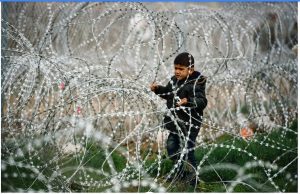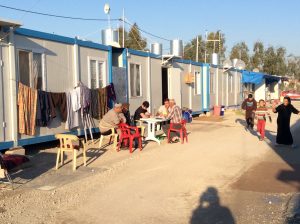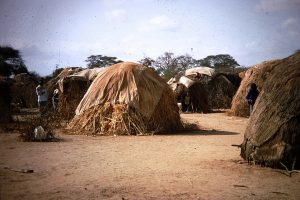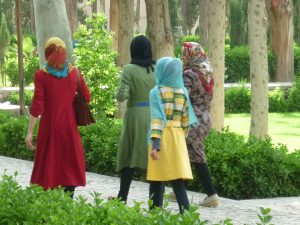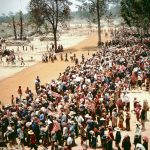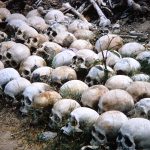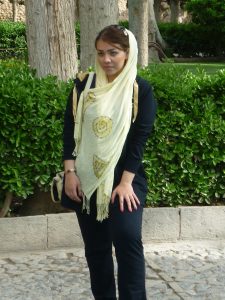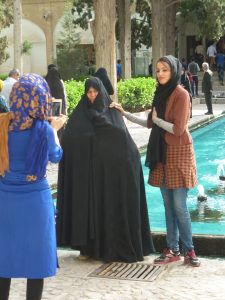The migration debate has emerged in the last 15 months in a manner where it is having a profound influence on the global political debate and has been a critical factor in decisions such as Brexit and is influencing the trajectory of the political alignment of many countries. What has changed in our world and do we understand the deeper currents that are creating this new and disturbing reality? Ban-Ki-Moon dedicated September 19, 2016 as a special refugee focus at the United Nations at a time when global leaders are present – to bring the catastrophic issues of displaced people to the attention of the world. (Many eloquent words were spoken but my initial assessment is that nothing material has changed). Although migration issues have seemingly come out of nowhere their roots can be found in developments that reach back at least to WWII. In this paper I look at the impact of history and venture into some of the more challenging questions such as the role of culture and religion. The problems related to migration will be with us for a long time!
The Changing Dynamics of Refugee Movements
Refugees like the poor have always been with us – and likely will be – but something changed in the summer of 2015. Images of desperate people filled our screens. Refugee issues began to impact both national and international politics. Equally important and somewhat surprising, news stories went beyond the sheer numbers and photogenic aspects of events and began to speak about the relevance of laws and conventions related to refugees and migrants.
Reporters began to report about the difference between an economic migrant and a refugee. Other stories attempted to explain the responsibility of governments to people crossing their borders. In Europe this took on the added dimension of a collective responsibility versus individual national responsibilities. Structures such as the Schengen Agreement designed to make borders less visible were suddenly threatened by people movements that had never been anticipated.
In the United States a national and rather toxic debate developed about the reality and rights of migrants. Countries such as Canada and Australia had the opportunity to use isolation as a defense. In Asia we learned of migrant groups in great difficulty such as the Rohingyas only when they appeared in the lens of a TV camera.
Something has changed and I will attempt to address that question in both a historical sense as well as consideration of the nature of refugee movements and how that matters.
- What has changed in numbers and nature of flows since WWII and since the drafting of the various Conventions related to refugees and migration.
- Do numbers matter? The Conventions speak about principles but does it matter if there is a significant change of scale?
- People are not simply people. They bring with them culture, language, religion, political views and experiences, racial differences, economic circumstances and in a world of information – differing expectations.
- Finally – are the various Principles embodied in the Human Rights Declaration or subsequent Conventions designed to deal effectively with this often dramatic and substantive shift in the nature and scale of refugee and migrant movement?
1. What has changed since WWII?
The Human Rights Declaration and subsequent Conventions were written and designed in the period immediately following WWII. They were written as a response to the particular nature of the migrant issues that arose from that catastrophic experience. The Declaration of Human rights was adopted in 1948 and other conventions followed. The drafters were in large part from Europe and the principles in these Conventions reflect the cultural and religious background of the period and the persons.
An important series of events after the War and often a product of the War was the process of de-colonization. We think of the dramatic events around the independence and then partition of the Indian sub-continent. Events led to the independence of countries such as Indonesia but more consequentially to the effort to dislodge the French in South East Asia that resulted in the VietNam War. This had important political ramifications plus the dislocation of populations – and the development of novel responses to refugees.
During the decades and centuries of colonization there was little thought given to the idea that persons who were treated in any particular way by the colonial master of one colony might be given civil rights in another – especially another colonial master. If you were treated in ways we would consider inhuman in a country like the Belgian Congo there was zero prospect that Britain or France would extend asylum – especially not in the home country. The point is that political repression, racism, famines and every other kind of persecution or problem might have been a feature of those times but it was unlikely to result in a flow of refugees that would be granted any universal political rights.
De-colonization changed our world and our understanding of rights in two important ways. First, there was a recognition that persons from former colonies would be considered as worthy of human values and rights as represented by the Declaration of Human Rights.
Second, there was the establishment of new post-colonial sovereign nations, often with inappropriate borders, absence of any Governance tradition and an inheritance of tribal, religious and cultural fragmentation that had never developed into a political understanding. There was an expectation that freedom would allow for political development that was more benign and reflected superior local values compared to whichever colonial master had existed before. Events proved this hope to be more than elusive and many Governments and leaders disappointed the world and more often their own citizens.
This substantive change in global political architecture must be understood and appreciated when we consider the current emergence of a different kind and scale of migration.
2. Do numbers matter?
Previous movement such as migration from Europe to the Americas was the relocation of surplus population to arguably relatively empty spaces – and into cultures which were similar. The current migrant surge is from the less developed world into a developed world that is really relatively small in comparison. Relevant developed destination countries are limited to North America, Australia and Western Europe. America is in the process of excluding itself so that leaves Europe with a modest contribution from a few others like Canada.
If we consider the period since 1980, countries such as Canada, the United States and China have increased their population by 40%. Considering the same period the countries of Northern Europe – such as Germany but including Poland, Russia and others have had zero increase. During that same period a number of the countries which are the source of war-affected or economic migrants such as Ethiopia, Nigeria, Bangladesh, Syria, Congo – have increased by 200%. Even more alarming from a purely demographic perspective this latter group has increased in population by 500% since the end of WWII or when the Human Rights and refugee Conventions were written.
This could lead to the conclusion that this disparity in population growth implies that Western Europe has a serious demographic problem and can therefore absorb migrants. That may have some truth but there is still a matter of scale. The problem is that many of the slow growth countries such as Japan or parts of Western Europe do not have a political or social culture that will readily accept refugees except at the margin. It is notable that Japan increased its approval of asylum applications by 50% over the past year. The increase was from a tenth of 1% to a seventh of 1% of applications!
The United States has a modest legal immigration program relative to its size but the movement of irregular or economic migrants from Latin America has actually been North to South for the past 5 years – in spite of the toxic political rhetoric. Geography in terms of source countries and physical access reduce the effective options for voluntary relocation from South Asia and Africa to Western Europe. Within Europe migrants themselves are predisposed to settle in a limited number of countries. In reality the available target destinations in Europe represent possibly 200 million people at a maximum plus Australia and Canada that are destinations that can strategically and politically manage some inflow. If countries such as Nigeria with 200 million and predicted to grow to 500 million continue to experience political chaos – which destination could possibly accept and integrate the overflow – and then add all of the other countries in current or potential trouble. Syria has only 22 million people – up from 5 million at the end of WWII and that modest population causes a crisis that is proving hard to manage.
The point is that all of the issues of culture, race, education skills and other issues aside – the numbers suggest that relocation is a limited option to deal with any future crisis and possibly even the present crisis. It is important to recognize that reality when we hear passionate appeals to live up to the obligations of the various Conventions and to consider our human and moral responsibility. Reality suggests that is not helpful if we do not understand the dimensions of the problem and the capacity of any available current and future solutions.
Before I continue with the role of culture and other differences I will address the frequently heard argument that countries adjacent to a conflict are carrying an inordinate share of the burden. If a civil war occurs in Guatemala or El Salvador and this results in forced migration to Honduras or Mexico to escape the violence, the argument could be made that Europe or New Zealand should share the burden – but we never heard that argument when such a migration did in fact occur. The same could be said of Bangladesh in 1971 when 10 million crossed the border to live in refugee camps near Calcutta. The current Middle East crisis is creating different views on burden-sharing and it is fair to ask why that region’s problems are different. One reality is that the Middle East today – at least the portions that were part of the Ottoman Empire – are essentially a single population that was divided artificially by the post WWI and post WWII borders. Arguably it was a single population in Ottoman terms but also a region historically divided into a multitude of tribal, religious and sectarian differences – although essentially similar racially and sharing a single dominant language and religion.
When populations cross borders from Afghanistan to northern Pakistan or Eastern Iran – they are arguably sharing space with similar people and often their own tribal relatives. When Syrians cross the border into Jordan the differences in nationality are essentially an accident of history – and they share most aspects of language, culture and traditions.
Why am I making this argument? If we go back to the prior questions of the history of colonization and the impact of numbers – we are facing a world where many regions will continue to be unstable or may become ungovernable over time. As migrants cross these new and artificial borders – is the answer to keep and support them in the region and invest in political and economic solutions or in each case relocate major populations to the relatively small proportion of the world that is wealthy and politically stable? Is there a risk that if not handled with care we destabilize the relatively few parts of the world that are currently stable with potentially severe negative consequences.
It should be noted that burden-sharing is not really a well-accepted principle. Although the oil-rich Gulf States need millions of workers and have wealth – they prefer to import more malleable employees from places like Nepal who will arrive without the burden and inconvenience for the locals of family – and can be sent home after the slightest indication of a desire for human rights or simply humane treatment. As an alternate the Gulf States could accept the well-trained displaced people from Syria or Iraq – including their families – who are seeking both employment and safety. These migrants or refugees share history, geography, language, religion and culture with these wealthy neighbors but are rejected – yet Europe is castigated for not accepting large flows of people who will struggle to integrate economically and as a consequence socially even under the most generous conditions of asylum.
Cambodia border 1980. In the middle of active conflict refugee camps do not even exist. I suppose simple survival is a form of success. I was part of those events.
The point I am trying to make is that the reality of numbers, artificial borders, a growing and variable list of failed states plus natural phenomena such as drought or climate change create circumstances that require us to re-evaluate the current concepts of asylum and mass relocation as a solution to the larger problem of global distress. The UN recently announced a goal of 10% of refugee populations to be re-settled. Where does that leave the 90%? Even if achieved this exceeds the historic pattern of resettlement by vast orders of magnitude. Actual resettlement has been less than 1% of official refugees annually – and that total excludes the 80% of migrants or IDP’s in distress who are not recognized officially by the UNHCR. I am not speaking against the need to grant asylum, selective resettlement or programs to assist migrants and other populations through periods of distress. I am simply making the point that the debates about asylum and other principled solutions are not and are unlikely to address the current and future nature and scale of the problem.
3. Does Culture Matter?
I risk being labeled as politically incorrect by venturing to speak about the role of culture in the current political and economic conflicts and their impact on migration. It is my view that we will not deal effectively with the sources of migration or their solution – if we do not consider the role of culture using the word in its broadest sense.
The Cold War dominated the period to 1990 in a way that masked many of the migration flows. Political circumstances did not permit local cultures to emerge as the decisive actors in local or national outcomes. The two Cold War protagonists supported whichever authoritarian ruler could keep tight control and support their side in the ideological conflict – human rights, gender equality and political freedom were of no consequence in that Faustian bargain.
I will frame my comments about the role of culture by using two well-known phrases – “The End of history “ and “The Clash of Civilizations.” The first was the essay and book titled “The End of History” by Francis Fukuyama published in 1992. It argued that the conflict about ideological choice was over and liberal democracy was the only remaining viable and acceptable alternative for Governance. Prof Samuel Huntington responded in a lecture later the same year using what has become a famous and infamous term – “Clash of Civilizations”, and agreed that the age of ideology may indeed have ended but predicted that the world would return to its more normal state of affairs which was conflict along the lines of culture or religion. That is vastly over-simplified but it is a good starting position for the discussion.
Both theories were criticized by the ruling political and academic elites and resulted in some interesting debate. Huntington responded in a creative way by joining with Lawrence Harrison and organizing a conference and the later book with the title “Culture Matters: How Values Shape Human Progress”. To avoid the anticipated criticism that would result from a Western academic critiquing other cultures – a reputable academic from each of the cultures being considered was selected and asked to critique from within. This was not a book about Islam versus the rest and Islam figured very lightly in the book. For generations we have been told that the legacy of colonialism explains the failure of certain parts of the world to develop. One example compared the post war and post-colonial experience of Taiwan and Korea – both traditional societies and colonies brutalized by Japan – and their successful economic and political emergence – with the experience of post-colonial nations in Africa or elsewhere. An interesting comparison is with a naturally endowed nation such as Argentina in which the statute of limitations for complaining about the colonial heritage has long expired – but a country with great promise that has failed to produce results.
Another comparison is Ghana which became independent while Korea was going through a brutal internal conflict. Both started the period with similar economic indicators – but today the Korean GDP exceeds that of Ghana by a factor of 15. The major point of the book is to consider the role that cultural inheritance plays in the ability of a society to respond to economic opportunities, the capacity to shape political structures that encourage the development of its human resources and the ability of a nation to navigate its neighborhood. The book does not judge the merits of the values of the Orthodox, versus the Confucian versus the Islamic versus the Catholic Latin American or the Protestant Northern Europe worlds – but it does analyze outcomes and does try to link these outcomes to attitudes and values.
The point I want to make is that culture, values and attitudes have an important and often decisive impact on how a society or group of people responds to opportunities and challenges. A completely different argument can be made about the role of the individual in responding to the particular cultural inheritance they bring with them. We can all recite anecdotally and often statistically the personal experience of individuals from various cultural, racial or religious backgrounds who have responded in ways that we – again using our own values – consider constructive, successful and positive.
I live in a City and Province that is in the midst of an astonishing anthropological experiment. The Provincial Nominee Program now known as PNP was invented here in 1998 and continues as the most successful program of its kind in Canada – and arguably globally. In recent years immigrants have arrived at the rate of 1.2% of the population annually – and the number would be higher if the Federal Government would stop putting impediments in the way. Some people expected migrants to use Manitoba as a convenient way to access Canada and relocate to cities like Toronto – this has not happened. Migrants have stayed, they have been received positively by the population and they have been overwhelmingly successful if measured by economic independence and a high degree of social integration.
Comparable rates of immigration into the US would be 4 million per year – or 400% of the current real rate of arrivals. In the case of Europe it would be 6 million per year – but they are overwhelmed by a rate of one million. I want to make two points. First – it is possible for a society to absorb a large number of migrants – but note that the receiving population was itself primarily former migrants and already viewed itself as multicultural – even if the variety was mainly of European origin. Secondly, the program was deliberate and planned. Arriving migrants came at all skill levels but represented a package of skills, life experience, aspirations and linkages to the Manitoba society that allowed for some predictability of success. Settlement assistance was also generous and carefully implemented.
How does this analysis relate to the current experience of Europe?
We have looked at some of the origins of current migration patterns such as de-colonization, the impact of demographics and the fact that culture matters. Stating that culture matters is different than saying one culture or religion is superior or unacceptable – but to ignore the reality of differences does not lead to any productive outcomes. I recently visited Tunisia where one objective was to understand why Tunisia alone in the Middle East has achieved some success – even if fragile – in the internal development of democratic governance.
Michael Moore in his recent provocative movie visited Tunisia to examine the revolution and in his interviews noted the critical role played by women in preserving the democratic impulses that emerged from the Arab Spring. I asked Tunisians why their country had a different political outcome and they quickly pointed to the role played by women and the much greater sense of gender equality in the country. They proudly pointed out that at the time of independence the country focused on education and gender equality as priorities and Tunisia was the first and possibly only Islamic country at that time to outlaw polygamy – and according to my interlocutors this created social and political space for women.
The debate about the role and problem of Islam in terms of current political and migrant issues sometimes attempts to analyze theology and quickly turns to the role of the conservative Wahhabi teaching. When this tendency inspires violence it is easy to say – “this is not the real Islam”. I spend my winters in a Mexican city and frequently walk by a house which is still labeled as the “House of the Inquisition”. My own ancestors were refugees from the Inquisition in the 16th century in Flanders and it is possible that much of the population was not supportive of that brutality either. Such an attitude would not have made the Inquisition less Catholic. Wandering around the Mediterranean basin this spring it was easy to note the brutality of empires or religions at various times. History is interesting and sometimes instructive but that history does not threaten the present – and that is why the challenge of a real or not real Islam needs to be dealt with – because the problem exists in the present. In the current reality Islam has the burden of dealing with the perception of theological and cultural differences that affect our individual and collective ability to solve conflicts or deal with desperate flows of migrants.
There is surprisingly little public analysis of the underlying issues in Islam that result in problematic cultural attributes that promote resistance by host populations – and sometimes resistance by migrant Muslim populations to accept the norms of the societies which receive them. It is not my purpose here to accomplish that difficult task but will make one observation. It has been asserted that the problem of acculturation into western societies by Muslim populations has related more to Eros than to Demos – another way of referring to issues of gender equality versus the ability to respond to democratic governance. Gender inequality or gender issues also feature in other cultures whether it be female mutilation or child brides – but these tend to affect the person or the community inward and do not affect the host population other than our disapproval.
When we consider the points of tension as reflected in our news stories they refer to female dress code, hesitance to mix in schools, the refusal to accept social norms such as a handshake or reported mob misbehavior in front of Cologne Cathedral. In societies like Saudi Arabia the distinctions are much more severe. The point is that issues many of us would refer to as gender inequality are the most visible points of tension and more open discussion may allow all parties to get beyond them. However, accepting inequality whether regarding gender, race or LGBT issues will not be the answer for open societies.
The question of Demos or the ability of Islamic or other cultures to accept democratic ideas of governance is interesting to analyze. We note the mixed history of Africa, Asia and Latin America and the only recent and incomplete democratization of Europe. There is no indication that the ability to accept communal governance values is genetic or antagonistic to adherents of most religions. However, experience with open societies is a very recent phenomenon and could benefit from study. In any event an open society is a value to be protected and we need to draw new arrivals into the democratic culture and not accept excuses that allow for authoritarian exceptions. The personal and collective freedom of our society is what attracts the asylum seeker and we need to both invite them to join and participate – but also insist that they accept or at least not damage these values.
The role of culture in many aspects of life is a challenging subject. Avoiding discussion and stating that all values are equal in terms of their impact on the success of a multicultural and diverse society and world is not helpful.
4. Is the Human Rights Declaration still relevant?
When the draft of the Declaration was circulated in 1947 the Anthropological Society of America declared it to be culturally biased and more or less stated that all societies and presumably their values should be considered as equal.
The Cairo Declaration of Human Rights in Islam passed in 1990 by the Organization of the Islamic Conference states that sharia is the sole source for the understanding of human rights.
How universal is the Universal Declaration really? The Declaration is admittedly entirely focused on the rights of the individual with scant reference to the rights of the collective. The problems currently experienced in Europe with regard to the challenge of the mass arrival of asylum seekers and the perceived threat to collective life and values illustrates the problem.
Whether universal or not the principle of asylum as stated in article 14 is not adequate to deal with the problems of our time as I have described them. I have worked personally in refugee or IDP situations including Bangladesh, boat people, Cambodia, Somalia and more recently the Middle East – so understand and am fully sympathetic. However, that experience has also taught me to question the relevance of our understanding of human freedom and the institutions and values that are intended to result in solutions.
Most of my family were refugees. This includes grandparents, parents, stepmother, both daughters and one son-in-law. I appreciate the need for and benefit of migration and asylum. We need to speak honestly to the issues that make borders and migration more rigid – and these discussions need to include history, scale and culture.
Bangladesh 1972. Beauty amid poverty.


